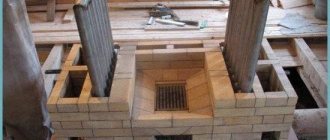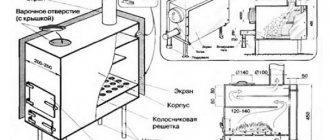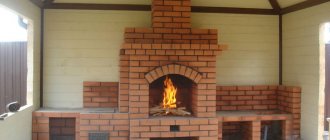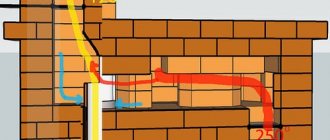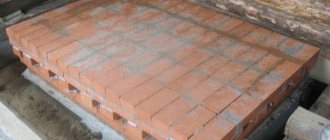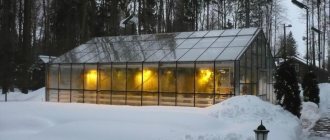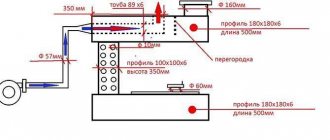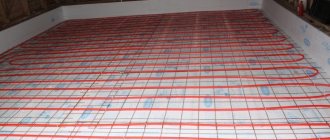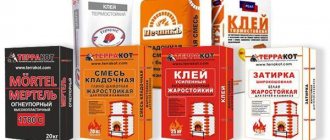Of course, in such a situation, you can use appropriate electrical appliances to heat the house and cook food or build a fireplace in the house. However, the best multi-purpose solution would be to install a brick kiln.
Description
Kuznetsov stove - Brick heater is a highly efficient heat retainer built from ceramic brick. Hot gases generated during the rapid and clean combustion of fuel in a firebox equipped with a sealed fireplace door pass through a series of channels and chambers, saturating the stone masses with heat. A proper brick stove then radiates heat into the area of the room. The high thermal mass maintains a constant thermal output, usually one firebox per day is sufficient. The advantage of such brick heaters is the high thermal power of the devices, since the amount of heat received from one firebox is distributed evenly over 12 to 24 hours. The high efficiency and low soot emissions of these heating stoves are an advantage for energy efficient homes using multiple fuels such as wood, etc.
Large brick regular Kuznetsov stoves, heating systems, are best used on a daily basis. Such heaters take a long time, with a full load of fuel, to warm up to normal operating temperatures when cold, and as such are not very suitable for occasional use. Periodic use of such heaters is not recommended!
Free movement of gases in the furnace
Application of the bell method
Kuznetsov fireplace stoves are assembled using a specific method, which has the following features:
- All gases and flows begin to be evenly distributed outside the combustion chamber;
- Depending on the number of hoods installed inside the structure, warm air is retained to a greater or lesser extent in the internal part of the unit, thereby providing fast, efficient and uniform heating;
- When installing the hood in close proximity to the combustion chamber, during melting, hot air vapors instantly enter inside and the installation, as well as the room, warms up several times faster;
- Due to the presence of caps, a minimal amount of soot and other deposits are formed, which greatly simplifies maintenance and cleaning;
- The heat exchanger must be installed exclusively outside the combustion chamber, which allows the efficiency to remain at the highest level and not decrease.
Kuznetsov's fireplace stove is designed in such a way that, as a result, exclusively cold air is released through a special hole located in the lower part of the installation, while hot vapors accumulate in special hoods.
In order to familiarize yourself in more detail with the finished work of fireplaces and stoves, we recommend viewing the photos located in this article.
Correct location
The main purpose of any furnace is heating; its location must be chosen to provide heat in the most efficient way. Kuznetsov stoves are infrared heaters that provide the greatest heat through direct radiation. Thus, maximum power is achieved with the correct positioning. Therefore, the center of the room is always the right choice. A wise decision is to place it as a divider between functional spaces, such as the kitchen and living room or living room and bedroom.
Try to avoid placing the masonry stove next to an outside wall or, even worse, placing it in a niche in an outside wall (a typical location for conventional fireplaces) if you want to keep the heat inside the room.
The choice of a stove of one type or another and its location in the house, in addition to the owner’s preferences, depends on the intended purpose of the stove, the size of the house and its level of thermal insulation, the number and size of windows. In addition, for normal operation and repairs, access to the stove must be free from all sides, that is, none of the sides of the stove should simultaneously enter any of the external walls of the house.
DIY instructions
Kuznetsov’s sauna stove can be folded either independently or with the help of professional stove makers. The cost of their services may vary, it all depends on the specific master.
If we voice an approximate price range, then such work will cost the owner of a bathhouse from 50,000 rubles and more, not counting materials. Therefore, if there is no budget, then you can do everything yourself.
The process of assembling and installing the elements of such a stove is very difficult. A Kuznetsov brick stove for a bathhouse with your own hands can be made and serve for many years only if all recommendations for its construction are strictly followed.
What materials are needed?
To carry out work on the independent construction of such a stove, you will need the following consumable building materials:
- Fire brick.
- Fine sand.
- Fireclay clay (sand and clay can be replaced with a ready-made store-bought mixture).
- Ordinary brick with a density of M150 and higher.
- Cement.
- Ruberoid (for waterproofing the foundation).
- Stainless steel sheets.
- Fine-fraction crushed stone for the base of the foundation.
- Boards for foundation formwork.
- Metal wire (for reinforcing masonry).
- Iron elements of the stove (doors, grates, grates, heater lining, decorative parts, dampers).
- Bath stones.
Required Tools
Tools and equipment you will need:
- Tanks for cement-sand and clay-sand mixtures, as well as a shovel for stirring them. You can use concrete mixers.
- A special furnace hammer in the form of a pickaxe.
- Mallet.
- Angle grinder, saw blades for stone and metal for it.
- Pliers, scissors for cutting metal. With their help, wire reinforcement will be made.
- Master OK.
- Rectangular trowel, rule.
- Marking tool.
- Measuring devices (tape tape, level, rope, plumb lines).
- A rag for wiping hands and removing residual solution.
- Personal protective equipment (goggles, respirator, gloves).
Foundation preparation
First, the foundation for the furnace is built:
- To do this, a pit is dug 0.5 meters deep and 10 centimeters larger than the dimensions of the future furnace.
- 15 centimeters of sand and small crushed stone are poured under the base of the foundation and compacted.
- A wooden formwork is placed on top, which should protrude 15-20 centimeters above the bathhouse floor. Next, the process of pouring cement mortar into the formwork and hardening it occurs.
- After the solution has completely dried, the surface of the foundation is covered with a layer of waterproofing and a heat-reflecting metal sheet.
- The walls adjacent to the stove are also lined with thermal insulation materials.
- A metal sheet is attached to the floor in front of the future firebox to protect against coals falling out of it.
Drawing
A drawing of Kuznetsov’s sauna stove can be seen in this image:
Laying and ordering
The general arrangement of the Kuznetsov stove for a bath is shown in the diagram below:
Adviсe:
- At the beginning of the solution preparation process, the clay should be soaked for 2 days. After this, you can begin kneading and laying rows. Each row should be placed on the dried previous one. After laying each row, using a system of plumb lines and a building level, the accuracy of the work must be checked.
- When laying a fire chamber made of fireclay bricks, it is allowed to use only a mixture of clay and sand. Mixing solutions of different types is strictly prohibited; this will lead to cracking of the dried masonry when it is heated.
- The first brick row is laid in a monolithic manner. From the second layer the chamber and space of the first cap are already laid out. Hinges are installed under the doors as needed. Every three rows, the layers are reinforced with pieces of wire, which are installed in the mortar joints.
- The combustion chamber is constructed of refractory bricks. There should be an air gap of several centimeters between it and ordinary brick. Bricks of different types should not touch each other, otherwise this will lead to cracking.
- After laying out the first cap, the construction of the second begins. Upon completion, the base of the chimney and the chimney itself are laid out.
- After completing all installation operations, the oven must be dried. During the initial two weeks, the stove dries naturally, with air circulating through open windows and doors of the bathhouse. All oven doors and dampers must also be open. Stones should be placed in a steam container only after the natural drying process of the furnace structure has been completed.
- At the beginning of the third week, it is already possible to carry out trial heating using a small amount of wood. With each subsequent ignition of the stove, the amount of firewood must be gradually increased. The stove should be fully heated no earlier than a month later.
Types of Kuznetsov brick kilns
- intended exclusively for heating the house;
- intended exclusively for cooking;
- combined - for heating the house and cooking.
The most popular types of brick kilns are:
— Traditional Russian trains RTIK. They are used for heating the house, cooking, and have a special shelf used for “warm” rest, drying and storing firewood and other purposes;
— Heating and cooking furnaces HOVIC. They are used for heating the home and cooking, and have a hotplate, oven and compartments for drying mushrooms. The advantage of the Swedish oven is its significantly smaller size.
There are various types of heating stoves OIK and heating stoves with a fireplace OIK K, as well as other types of stoves for homes, both combined and purpose-built; in Russia they are used very often (Bread heaters, heaters for baths, oriental stoves for cooking in a cauldron and etc.).
Construction process
Despite such diversity, the mandatory components of all Kuznetsov furnaces are:
- a solid reinforced concrete or rubble stone strip foundation, separate from the foundation of the house. Typically, the installation of a stove is planned simultaneously with the construction of a house, but if such an idea arises when a house has already been built, the foundation for the stove should be installed separately. In this case, the foundation extends 5 cm or more beyond its edges, an insulating layer (usually roofing felt) is laid on it, then asbestos, roofing iron and a lining made of mineral wool or felt;
— a firebox, the size of which is strictly linked to the size of the stove;
- ash ash pan, which requires constant and thorough cleaning;
— grate for placing solid fuel on it;
- a chimney that also requires regular and high-quality cleaning.
Laying each row of bricks when building a kiln is the most difficult process. This is the only case when each brick of each row and each built-in element of the furnace are laid in a strictly defined sequence and according to precise technology.
Thus, the first and second rows of bricks are installed on the foundation with a solid slab, and it is not recommended to fill the empty areas formed in the middle with scrap; the ash ash pan door is installed on the second row, and the ash ash pan itself is constructed from the third to the fifth row, etc.
The order and sequence of such construction is established by so-called schemes - orders; At the same time, experts recommend first building a dry model of the stove, and then, having disassembled and numbered each brick and every part, laying out the stove in real life.
Video Project of Kuznetsov's bell furnace:
Some features
There are several types of fuel - solid fuel, charcoal or coal, firewood and coke. Experienced blacksmiths prefer fuel such as coke, but it costs much more than regular coal. Although its consumption is much less than coal, about 5 times.
Experienced blacksmiths recommend using coke for ignition.
If we talk about forging metal in an artistic style, then this is the best fuel to use. Coke will give a fairly high hearth temperature. And because of all this, forging will be performed well, and there will not be a lot of soot and waste in the form of slag.
If you have decided on coke, then it is best to purchase coke. This is the same coke, only much smaller. If you take a large one, you will still need to split it into small pieces. This will take a lot of time, which you can spend usefully.
There are also furnaces that run on gas or liquid fuel, but this fuel option is usually used in larger-scale production.
The forge furnace is quite simple to operate.
The working surface is the place where the main forging work is done. Coal burns on it, which will heat the steel blanks. At the moment, there is a wide variety of structures and designs of such forges. They have their differences due to the fuel that is used on them.
Safety
The main requirement for any type of oven is its safety. In addition to the fact that the use of a constant open fire in the house always sharply increases the risk of fire, the combustion of any type of fuel produces carbon dioxide, which is extremely dangerous for humans, which, if the design is defective or improperly used, leads to carbon dioxide poisoning.
Therefore, if the owner of the house does not have stove construction skills, the construction of the stove should be entrusted to a master, despite the high cost of this work. Only a specialist will be able to lay bricks in the stove correctly with minimal gaps and correctly install the chimney and pipe, taking into account all possible nuances of its operation, including the prevailing wind direction.
About the author-inventor
IGOR VIKTOROVICH KUZNETSOV is the author of many inventions concerning the designs of household brick bell-type stoves for various purposes and different capacities: heating, heating-cooking, Russian stoves, stoves for baths with regulation of water heating and regulation of temperature and humidity conditions in the steam room of the bath. He patented these designs, combined with fireplaces, while the walls of the fireplace are heated and are part of the stove. I.V. Kuznetsov developed stoves for various functional purposes with built-in water boilers for use as a reserve in water heating systems. Now he is the chairman of the socially oriented NP “Development of the Kuznetsov Furnace System”
Pros and cons of water heating
Compared to a standard village stove, Kuznetsov’s model produces almost three times more heat. This allows it to be used for heating large houses and spacious summer cottages, despite the fact that the total cost of fuel will be the same.
Consumable materials for combustion are wood and coal, which are sold at a fairly convenient price, can be delivered to your home, and can be stored in a nearby building. It is also possible to build a special canopy, but then it is better to build it so that there are at least three walls, and the firewood or coals through the fourth are not wetted by precipitation.
The efficiency of the Kuznetsov furnace is almost twice as high, and constant heating will not spoil, but will only benefit the brickwork.
High-quality brick and cement mortar are not the most expensive materials, so it is quite possible to make a good, budget stove.
Advantages and disadvantages of the design
On the other hand, this option is completely unsuitable for warming a small house - it will be too hot.
During the period from late spring to early autumn, it will not be possible to use the unit for cooking, so you will have to look for an alternative solution to the power problem.
The water boiler installed inside must be changed periodically, since constant heating to extreme temperatures damages the integrity of the metal tank.
